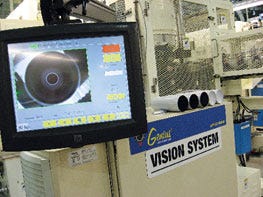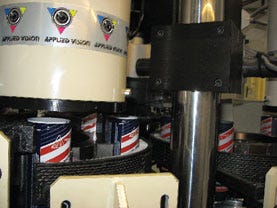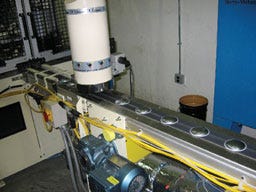Vision inspection: A closer eye on can inspection

The two cameras on the can line are installed side by side after the top-flange forming operation. The first camera checks the shoulder and sidewall, while the second inspects the flange. The image of each can and dome is shown on an operator screen as they pass beneath the cameras.
Sophisticated vision-inspection systems are helping DS Containers [www.dscontainers.com] (DSC) maintain the quality of its unique two-piece, polymer-coated steel can—the first consumer package of its kind in the U.S. DSC opened a 236,000-sq-ft plant in Batavia, IL in 2005 that uses proprietary technology developed by its partner, Daiwa Can Company of Japan (www.daiwa-can.co.jp), to produce a unique deep-draw steel can. The new container initially targets the aerosol sector, but is equally adaptable to nonaerosol applications.
DSC is a unique Japanese/American partnership. DS is derived from Daiwa-Seikan, which are the Japanese words for canmaking, and the Batavia plant has been outfitted with state-of-the-art production equipment using proprietary Daiwa technology. Modeled after Daiwa's successful "bottle can", an aluminum beverage can made in Japan, the DSC container applies Daiwa's polymer-coating technology to produce steel aerosol cans that address the limitations of steel and are suitable for personal care items. The polymer-coated steel, tradenamed Protact(R), is produced at Corus Packaging Plus (www.corusgroup.com/en) in Europe. It combines the integrity of steel with the versatility and protective properties of plastic. The finished cans are scratch-, corrosion- and rust-resistant, eliminating the need for interior and exterior coatings that are used in conventional can manufacturing.

DSC has two can-manufacturing lines in its new plant, each producing about 600 cans/min. Each line has three Genius(R) vision-inspection systems from Applied Vision (www.appliedvision.com). Two of these systems are used to inspect the cans after they are formed, while the third system on each line inspects the bottom domes (can ends) before they are attached to the cans. "Inspection of the cans and domes is essential to our operation," says vp-manufacturing Bill Smith. "In particular, the integrity of the laminated interior is critical. Our customers fill very aggressive products in these containers, and it is imperative that there be a complete barrier with no scratches, voids or dents. The containers that are delivered to our customers must be perfect, with absolutely no defects."
For more information about vision inspection, go to Packaging Digest's homepage and click on the AUTOMATION TECHNOLOGY CHANNEL at http://www.packagingdigest.com/ info/automation
The two cameras on the can line are installed side by side after the top-flange forming operation. The first camera checks the shoulder and sidewall, while the second inspects the flange. Both inspect the can interior for defects in the coating. The cameras also look for a myriad of possible defects including creases, puckers, wrinkles, neck pleats, die/draw marks, scratches, dents, coating voids, narrow flange, flange defects, flange measurement, grease and oil stains, foreign objects, metal whiskers and more. The camera on the dome line inspects the bottom domes as they pass beneath on a conveyor before they are attached to the can bodies. All of the systems use high-speed analog cameras with the optical configuration set up for the inspections taking place.

The two cameras on the can line are installed side by side after the top-flange forming operation. The first camera checks the shoulder and sidewall, while the second inspects the flange.
The systems use light-emitting diodes to provide illumination, and the light intensity, color, lenses and other parameters are unique for each installation. The image of each can and dome is shown on an operator screen as the cans pass beneath the cameras.
The Genius systems incorporate Applied Vision's proprietary intuitive Touch-n-Go(R) user interface that makes programming simple and ensures image processing and analysis that detect the smallest defects. Operators essentially teach the system to identify different defects as they appear on the screen rather than draw from a library of possible preassigned defects. The system maintains a count of each type of defect detected and can be set up to alert the operator if the percentage of a specified type of defect reaches a preset level.

The camera on the dome line inspects the bottom domes as they pass beneath on a conveyor before they are attached to the can bodies.
One key to DSC's successful inspection program is that the inspection systems were integrated into the canmaking equipment by the equipment manufacturer. "DS containers is a great example of how to be smart when investing in machine-vision technology," says Applied Vision's vp of sales (Europe) Joseph Bica. "Many companies still view this as an afterthought; something to implement once they've experience quality problems or once they have production set up. DS Container involved Applied Vision from the very beginning, so they were able to identify how machine vision best fit into the production flow, and how it could work most effectively to identify flaws as early in the process as possible. It paid off in every area—from development of their system to installation to ongoing support."
DSC has been very satisfied with the results. "Our goal from the beginning was to have zero defects in the cans leaving our plant, and Applied Vision is assisting us in meeting that vision," says Smith. "They were with us when we started the plant and helped train all of our operators. Since then, they've given us great service, and have been very responsive when we needed anything. They've met all of our expectations with no disappointments."
More information is available:
Applied Vision, 330/926-2223.www.appliedvision.com.
Corus Packaging Plus, 31 (0) 251 49 3186. www.corusgroup.com/en.
Daiwa Can Co., 011 81 3 3272 0561. www.daiwa-can.co.jp.
DS Containers, 630/406-1306.www.dscontainers.com.
About the Author(s)
You May Also Like


